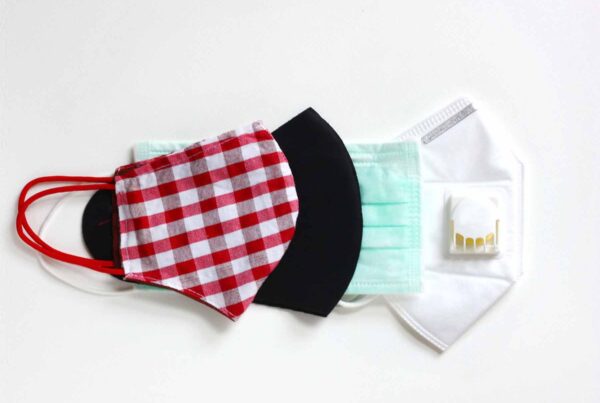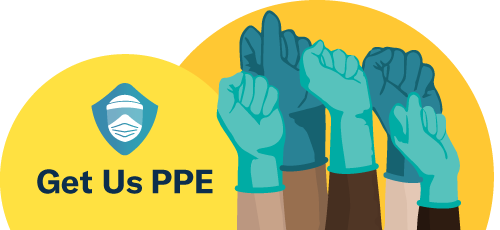By Alison Mosier-Mills, a blog contributor at GetUsPPE.org.
On Thursday, May 21, GetUsPPE’s Dr. Megan Ranney testified before the Select Subcommittee on the Coronavirus. She discussed the impact of the crisis on medical staff and first responders, highlighting the urgent need for protective gear and proposing a path toward a sustainable and equitable supply chain. These priorities will be essential to providing high-quality care to Covid-19 patients while also ensuring the well-being of the frontline workers who treat them.
Across the country, hospitals have been overwhelmed by the volume of patients requiring intensive treatment for Covid-19—and many frontline healthcare workers have been forced to confront the crisis without the equipment necessary to safely treat sick patients. As of mid-April, the CDC estimated that the coronavirus crisis had claimed the lives of at least 27 health care professionals and sickened more than 9,200, and these numbers are likely underestimates. The root of this crisis, Dr. Ranney testified, stems from the fact that much of the United States’s PPE is manufactured abroad, and the U.S. did not ramp up domestic production in the early days of the crisis, leaving many hospitals in the lurch.
As a result, healthcare systems faced a limited ability to purchase protective equipment, leading to competition between hospitals, price-gouging—the cost of a single protective suit suddenly jumped from $1 to between $10 and $20, she said—and the proliferation of counterfeit products. “Not only did we drive prices up, but we also saw the minimum order number go up,” Dr. Ranney testified. “Most hospitals can’t pay cash on hand, which is what a lot of suppliers were asking for.”
For Dr. Ranney and her colleagues across the country, these deficiencies have compromised their ability to care for patients, introduced wrenching ethical dilemmas, and exposed them to the virus itself. These realities will have profound ongoing physical and mental health implications for healthcare workers, many of whom are already experiencing symptoms of PTSD. “Speaking personally, I am frustrated and exhausted,” Dr. Ranney said. “Speaking on behalf of my colleagues, we are experiencing higher levels of burnout, anxiety, sleeplessness, and depression.”
But Dr. Ranney also emphasized hope: in the time since its founding, GetUsPPE has seen a remarkable influx of donations that have enabled them to coordinate and distribute protective gear to healthcare workers across the country—including to those in communities without resources. But this effort highlights the greater need for long-term solutions. “The creation of a Medical Supply Coordinator in the HEROES Act is a step in the right direction, but to be clear: we must ramp up domestic manufacturing, increase the stockpile available for distribution to states, enhance data on PPE and other supply needs, and ensure that PPE is distributed equitably to everyone who needs it,” Dr. Ranney said.
The full text of Dr. Ranney’s testimony appears below. You can view a video recording of the full hearing here.
Congressional Briefing on Heroes of Coronavirus Response
House Select Committee on the Coronavirus Crisis
May 21, 2020
Respectfully submitted by:
Dr. Megan L. Ranney MD MPH FACEP
Associate Professor of Emergency Medicine, Alpert Medical School, Brown University
Director, Brown Emergency Digital Health Innovation program
Co-Founder, GetUsPPE.org
I’d like to start by thanking the other panelists who will be talking about their experiences later today; and thank you to Chair Clyburn and Ranking Member Scalise and the rest of the members of the Committee for the opportunity to talk about these issues today.
I am an emergency physician and public health researcher at Brown University. Today, I am going to share my perspective on the COVID19 crisis from both vantage points. I want to touch on three topics: First, the shortages of personal protective equipment, or “PPE”; Second, the physical and mental effects on ER doctors and other frontline healthcare workers; and Third, what comes next with re-opening.
A little over two months ago, the life of every healthcare worker in the country changed for the worse. My own hospital system had been preparing for the pandemic since the novel coronavirus was first reported; we had done our best to build up our pre-existing stores of masks and gowns. However, by mid-March, as sick patients poured into our doors, our PPE “burn rate” had gone through the roof and the supply chain had dried up. In normal times, we would dispose of our PPE – our gowns, gloves, masks, and so on – in between each potentially infectious patient, to keep ourselves & our patients safe. As our ERs and ICUs filled with patients, however, this meant that the average doctor or nurse would go through 40 or more masks in a day. Hospitals, counties, and states across the country were all running out of this essential protective gear.
And there was no more to be had. Overseas manufacturing had been diverted to other hotspots like Italy and China. Our national stockpile was inadequate. The U.S. had not ramped up production in time. As a result, as you know well, we were told by the U.S. Centers for Disease Control & Prevention to use bandanas — which have NO efficacy in the healthcare setting — when we ran out of masks.
To be clear: without adequate PPE, frontline workers like those who have joined us today, are unable to protect themselves from becoming infected. As a result, over the last two months, I have innumerable colleagues across the country who have been infected by COVID19. Some have been hospitalized, and some have died.
Now, in emergency medicine, we are used to “doing without”. Every day we have our finger in the dike of the American healthcare system.
But nothing prepared us for COVID19.
Overnight, our emergency department was full of really, really sick patients for whom we had few treatments. Our patients were alone: no visitors were allowed. We healthcare workers were scared, both of getting sick ourselves and of failing our patients. Because of shortages of PPE, we couldn’t sit at the bedside and hold their hands. Because of lack of scientific knowledge and lack of supplies, we often couldn’t save them.
And as the COVID19 case counts climbed, hospitals began running out of not just PPE, but also other essential supplies. Basic medications, like the medicines we use to sedate a patient who’s on a ventilator. Basic supplies, like the spacers we use to administer albuterol. Lifesaving equipment, like dialysis machines and ventilators. We were operating with levels of supplies, and facing ethical dilemmas, that we would not normally tolerate.
As a result, many of us felt abandoned – like we were on our own. And the secondary trauma from this experience is only just beginning to be felt.
Speaking personally, I am frustrated and exhausted. Speaking on behalf of my colleagues, we are experiencing higher levels of burnout, anxiety, sleeplessness, and depression. We are beginning to see signs of PTSD. And, sadly, we are seeing much worse aftereffects. I’m sure that many of you read about Dr. Lorna Breen, a fellow emergency physician who died of suicide after the stress of being infected herself while trying to run an ER that couldn’t help the many dying patients in its hospital rooms and hallways.
That said, I am also here to talk about hope. In the early days of the pandemic, I and many other healthcare workers began to speak out on Twitter and in the media about our experiences. Our inboxes were deluged with offers for donations of PPE. These offers were kind and tremendously helpful to my hospital. But they also felt unfair: What about hospitals in communities where people don’t have the resources to donate?
Seeing no national, coordinated response to the lack of PPE, in mid-March I and a group of other physicians co-founded GetUsPPE to help fill the gap in supplies. Our initial goal was to find unused PPE in non-medical settings and connect those who could donate masks and gloves to healthcare workers in need. Within a week, we had received requests for PPE from over 1000 healthcare facilities across the country. Within a month, we had received 7000 requests, with every state represented in our database. In collaboration with regional and corporate partners, ranging from medical students in Chicago to Boston Scientific to tribal nations to Amazon, delivered more than 1.6 million pieces of PPE to healthcare facilities.
But we know that this is not enough. In the last two weeks alone, we’ve had thousands of new requests for PPE. Early on, everyone needed surgical masks. Now, while N95 respirators are still in high demand, we are seeing new shortages for gowns, PDI wipes, and other essential supplies.
One thing is clear: the PPE shortage continues in America and it will affect our country for months to come.
Reopening will exacerbate the need for PPE: as restrictions are easing, and more institutions are opening their doors, more frontline workers need to be protected. We need the federal government to step up. The creation of a Medical Supply Coordinator in the HEROES Act is a step in the right direction, but to be clear: we must ramp up domestic manufacturing, increase the stockpile available for distribution to states, enhance data on PPE and other supply needs, and ensure that PPE is distributed equitably to everyone who needs it. And “everyone” is not just doctors and nurses; it is all essential frontline workers who have been bearing the brunt of this crisis without necessary protection.
Over the past 2 months, I have seen the best & the worst of America. I have hope, based on the ingenuity and kindness of Americans across the country. But we need your help.




